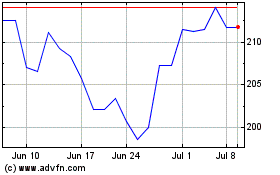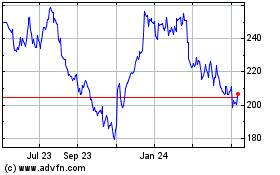Teleflex Reports Study Using Its Arrow® EZ-IO® Intraosseous Vascular Access System Shows Advantages for Medical Emergencies
July 29 2015 - 4:30PM
Business Wire
Peer-Reviewed, Prospective Study Confirms
Intraosseous Access May Provide Faster, More Accurate Vascular
Access than Central Venous Catheters for Emergencies Involving
Adult Patients
Teleflex Incorporated (NYSE: TFX), a leading global provider of
medical devices for critical care and surgery, announced that newly
published research has documented important advantages of
intraosseous vascular access over central venous catheterization
for medical emergencies involving adult patients.1 The company’s
ARROW® EZ-IO® Intraosseous Vascular Access System was the
intraosseous vascular access device used in the study.
Intraosseous vascular access refers to the process of
administering medications or other fluids into the bone marrow to
gain a pathway to the body’s vascular system. After first being
demonstrated in the 1940s, the process has gained new popularity
since guidelines from the American Heart Association recommended
that providers use it when circumstances make regular intravenous
access difficult or impossible.1
This peer‐reviewed article described a clinical study designed
to compare intraosseous vascular access to landmark-guided central
venous catheter (CVC) placement during inpatient medical
emergencies at a large urban teaching hospital. The study was part
of a quality improvement initiative, reporting on intraosseous
access for an inpatient rapid emergency team response. The in-press
article appears online in the respected journal Critical Care
Medicine, the official journal of the Society of Critical Care
Medicine.
The study involved 79 adults who received central access between
February 2012 and July 2013. The events investigated included 79
medical emergency team calls, encompassing 60 non-arrests and 19
cardiac arrests. Of the 79 patients, 31 received intraosseous
access with the ARROW® EZ-IO® System and 48 received a
CVC.
The results demonstrated the benefits of intraosseous access in
emergency circumstances in several ways. First-pass success rates
with intraosseous access were substantially higher than with the
CVC: 90.3% vs. 37.5%. Overall success rates with intraosseous
access were superior, as well, with a rate of 96.8% for the
ARROW® EZ-IO® System and an 81.3% rate for CVC access.
CVC placements took significantly longer than intraosseous access –
an average of 10.7 minutes compared to 1.2 minutes for the
intraosseous route.
In total, mean attempts to place a CVC per patient were almost
three times higher than intraosseous attempts (2.8 vs 1.1) and more
CVC kits were used on average per patient than intraosseous kits
(1.3 vs 1.1). All of the above results were statistically
significant.
“As the market leader in vascular access, we continue to partner
with clinicians to expand their options for vascular access,” said
Jay White, President of the Teleflex Vascular Access Division. “Our
full line of vascular access solutions provides clinicians with the
ability to select the right line for the right patient at the right
time, optimizing patient outcomes. This study has done an excellent
job demonstrating the benefits of the ARROW® EZ-IO® System during
inpatient medical emergencies.”
The ARROW® EZ-IO® System was also discussed in a literature
review published last year in Journal of Clinical Anesthesia. The
author, Jonathan A. Anson, M.D., suggests a framework for
incorporating intraosseous technique into clinical anesthesia
practice and compares currently available technologies. One of the
studies described in the review is a seven-year retrospective
analysis showing that the battery-powered ARROW® EZ-IO® System
had a much greater first-attempt success rate (96%) than either a
leading impact-driven device (55%) or a manual technique (50%).
Other studies included in the review found similar results for the
ARROW® EZ-IO® System versus the impact-driven system and also
demonstrated that the ARROW® EZ-IO® was easy to learn and
use.
Overall in the studies cited in the review, the
ARROW® EZ-IO® System had a greater insertion success rate
than either of the two leading impact-driven devices. It also had a
substantially faster mean insertion time (60 sec.) than the other
two devices (86 sec. and 101 sec.) In three prospective studies
described in the review involving a total of 130 patients, no
infections occurred.2
Additional information on the ARROW® EZ-IO® System can
be found at www.teleflex.com. Clinical education resources on the
technology can be viewed at
www.teleflex.com/en/usa/ezioeducation/index.html.
About Teleflex Incorporated
Teleflex is a leading global provider of specialty medical
devices for a range of procedures in critical care and surgery. Our
mission is to provide solutions that enable healthcare providers to
improve outcomes and enhance patient and provider safety.
Headquartered in Wayne, PA, Teleflex employs approximately 12,200
people and serves healthcare providers worldwide. For additional
information about Teleflex please refer to www.teleflex.com.
Forward-Looking Statements
Any statements contained in this press release that do not
describe historical facts may constitute forward-looking
statements. Any forward-looking statements contained herein are
based on our management's current beliefs and expectations, but are
subject to a number of risks, uncertainties and changes in
circumstances, which may cause actual results or company actions to
differ materially from what is expressed or implied by these
statements. These risks and uncertainties are identified and
described in more detail in our filings with the Securities and
Exchange Commission, including our Annual Report on Form 10-K.
Teleflex, Arrow, and EZ-IO are trademarks or registered
trademarks of Teleflex Incorporated or its affiliates.
© 2015 Teleflex Incorporated. All rights reserved. MC-001511
References:
1. Lee PM, Lee C, Rattner P, Wu X, et al.
Intraosseous versus central venous catheter utilization and
performance during inpatient medical emergencies. Crit Care
Med, 2015;43(6):1233-38.
2. Anson JA. Vascular access in resuscitation: Is
there a role for the intraosseous route?
Anesthesiology 2014;120(4)1015-31.
View source
version on businesswire.com: http://www.businesswire.com/news/home/20150729005016/en/
Teleflex IncorporatedJake ElguiczeTreasurer and Vice President,
Investor
Relations610-948-2836jake.elguicze@teleflex.comwww.teleflex.com
Teleflex (NYSE:TFX)
Historical Stock Chart
From Mar 2024 to Apr 2024

Teleflex (NYSE:TFX)
Historical Stock Chart
From Apr 2023 to Apr 2024
